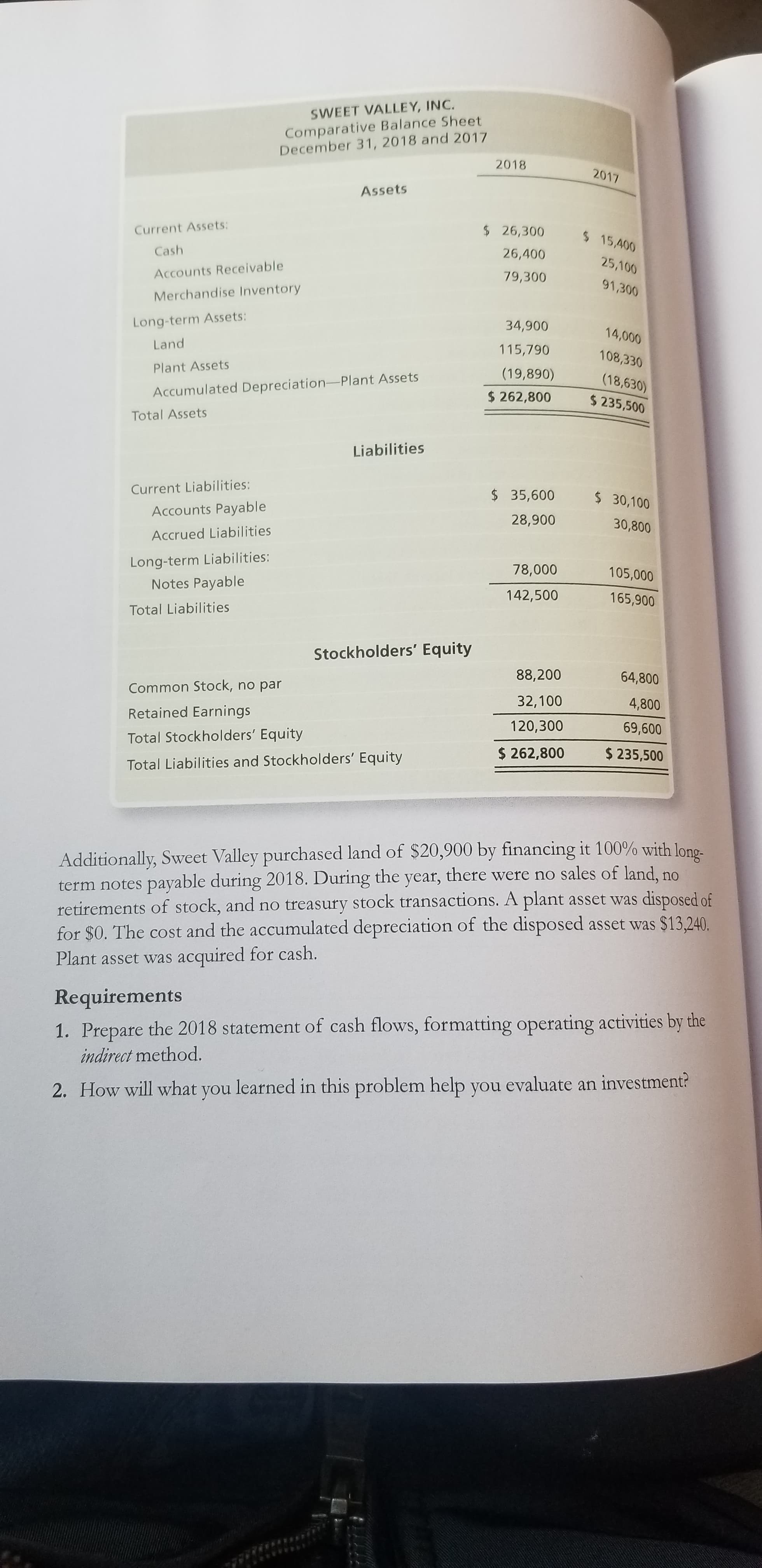SWEET VALLEY, INC. Comparative Balance Sheet December 31, 2018 and 2017 2018 2017 Assets $ 26,300 Current Assets: $ 15,400 Cash 26,400 25,100 Accounts Receivable 79,300 91,300 Merchandise Inventory Long-term Assets: 34,900 14,000 Land 115,790 108,330 Plant Assets (19,890) (18,630) Accumulated Depreciation-Plant Assets $ 262,800 $ 235,500 Total Assets Liabilities Current Liabilities: $ 35,600 $ 30,100 Accounts Payable 28,900 30,800 Accrued Liabilities Long-term Liabilities: 78,000 105,000 Notes Payable 142,500 165,900 Total Liabilities Stockholders' Equity 88,200 64,800 Common Stock, no par 32,100 4,800 Retained Earnings 120,300 69,600 Total Stockholders' Equity $ 262,800 $ 235,500 Total Liabilities and Stockholders' Equity Additionally, Sweet Valley purchased land of $20,900 by financing it 100% with long- term notes payable during 2018. During the year, there were no sales of land, no retirements of stock, and no treasury stock transactions. A plant asset was disposed of for $0. The cost and the accumulated depreciation of the disposed asset was $13,240. Plant asset was acquired for cash. Requirements 1. Prepare the 2018 statement of cash flows, formatting operating activities by the indirect method. 2. How will what you learned in this problem help you evaluate an investment?
SWEET VALLEY, INC. Comparative Balance Sheet December 31, 2018 and 2017 2018 2017 Assets $ 26,300 Current Assets: $ 15,400 Cash 26,400 25,100 Accounts Receivable 79,300 91,300 Merchandise Inventory Long-term Assets: 34,900 14,000 Land 115,790 108,330 Plant Assets (19,890) (18,630) Accumulated Depreciation-Plant Assets $ 262,800 $ 235,500 Total Assets Liabilities Current Liabilities: $ 35,600 $ 30,100 Accounts Payable 28,900 30,800 Accrued Liabilities Long-term Liabilities: 78,000 105,000 Notes Payable 142,500 165,900 Total Liabilities Stockholders' Equity 88,200 64,800 Common Stock, no par 32,100 4,800 Retained Earnings 120,300 69,600 Total Stockholders' Equity $ 262,800 $ 235,500 Total Liabilities and Stockholders' Equity Additionally, Sweet Valley purchased land of $20,900 by financing it 100% with long- term notes payable during 2018. During the year, there were no sales of land, no retirements of stock, and no treasury stock transactions. A plant asset was disposed of for $0. The cost and the accumulated depreciation of the disposed asset was $13,240. Plant asset was acquired for cash. Requirements 1. Prepare the 2018 statement of cash flows, formatting operating activities by the indirect method. 2. How will what you learned in this problem help you evaluate an investment?
Financial Accounting: The Impact on Decision Makers
10th Edition
ISBN:9781305654174
Author:Gary A. Porter, Curtis L. Norton
Publisher:Gary A. Porter, Curtis L. Norton
Chapter13: Financial Statement Analysis
Section: Chapter Questions
Problem 13.10E
Related questions
Question

Transcribed Image Text:SWEET VALLEY, INC.
Comparative Balance Sheet
December 31, 2018 and 2017
2018
2017
Assets
$ 26,300
Current Assets:
$ 15,400
Cash
26,400
25,100
Accounts Receivable
79,300
91,300
Merchandise Inventory
Long-term Assets:
34,900
14,000
Land
115,790
108,330
Plant Assets
(19,890)
(18,630)
Accumulated Depreciation-Plant Assets
$ 262,800
$ 235,500
Total Assets
Liabilities
Current Liabilities:
$ 35,600
$ 30,100
Accounts Payable
28,900
30,800
Accrued Liabilities
Long-term Liabilities:
78,000
105,000
Notes Payable
142,500
165,900
Total Liabilities
Stockholders' Equity
88,200
64,800
Common Stock, no par
32,100
4,800
Retained Earnings
120,300
69,600
Total Stockholders' Equity
$ 262,800
$ 235,500
Total Liabilities and Stockholders' Equity
Additionally, Sweet Valley purchased land of $20,900 by financing it 100% with long-
term notes payable during 2018. During the year, there were no sales of land, no
retirements of stock, and no treasury stock transactions. A plant asset was disposed of
for $0. The cost and the accumulated depreciation of the disposed asset was $13,240.
Plant asset was acquired for cash.
Requirements
1. Prepare the 2018 statement of cash flows, formatting operating activities by the
indirect method.
2. How will what you learned in this problem help you evaluate an investment?
Expert Solution
This question has been solved!
Explore an expertly crafted, step-by-step solution for a thorough understanding of key concepts.
This is a popular solution!
Trending now
This is a popular solution!
Step by step
Solved in 3 steps with 1 images

Recommended textbooks for you

Financial Accounting: The Impact on Decision Make…
Accounting
ISBN:
9781305654174
Author:
Gary A. Porter, Curtis L. Norton
Publisher:
Cengage Learning

Survey of Accounting (Accounting I)
Accounting
ISBN:
9781305961883
Author:
Carl Warren
Publisher:
Cengage Learning

Intermediate Accounting: Reporting And Analysis
Accounting
ISBN:
9781337788281
Author:
James M. Wahlen, Jefferson P. Jones, Donald Pagach
Publisher:
Cengage Learning

Financial Accounting: The Impact on Decision Make…
Accounting
ISBN:
9781305654174
Author:
Gary A. Porter, Curtis L. Norton
Publisher:
Cengage Learning

Survey of Accounting (Accounting I)
Accounting
ISBN:
9781305961883
Author:
Carl Warren
Publisher:
Cengage Learning

Intermediate Accounting: Reporting And Analysis
Accounting
ISBN:
9781337788281
Author:
James M. Wahlen, Jefferson P. Jones, Donald Pagach
Publisher:
Cengage Learning